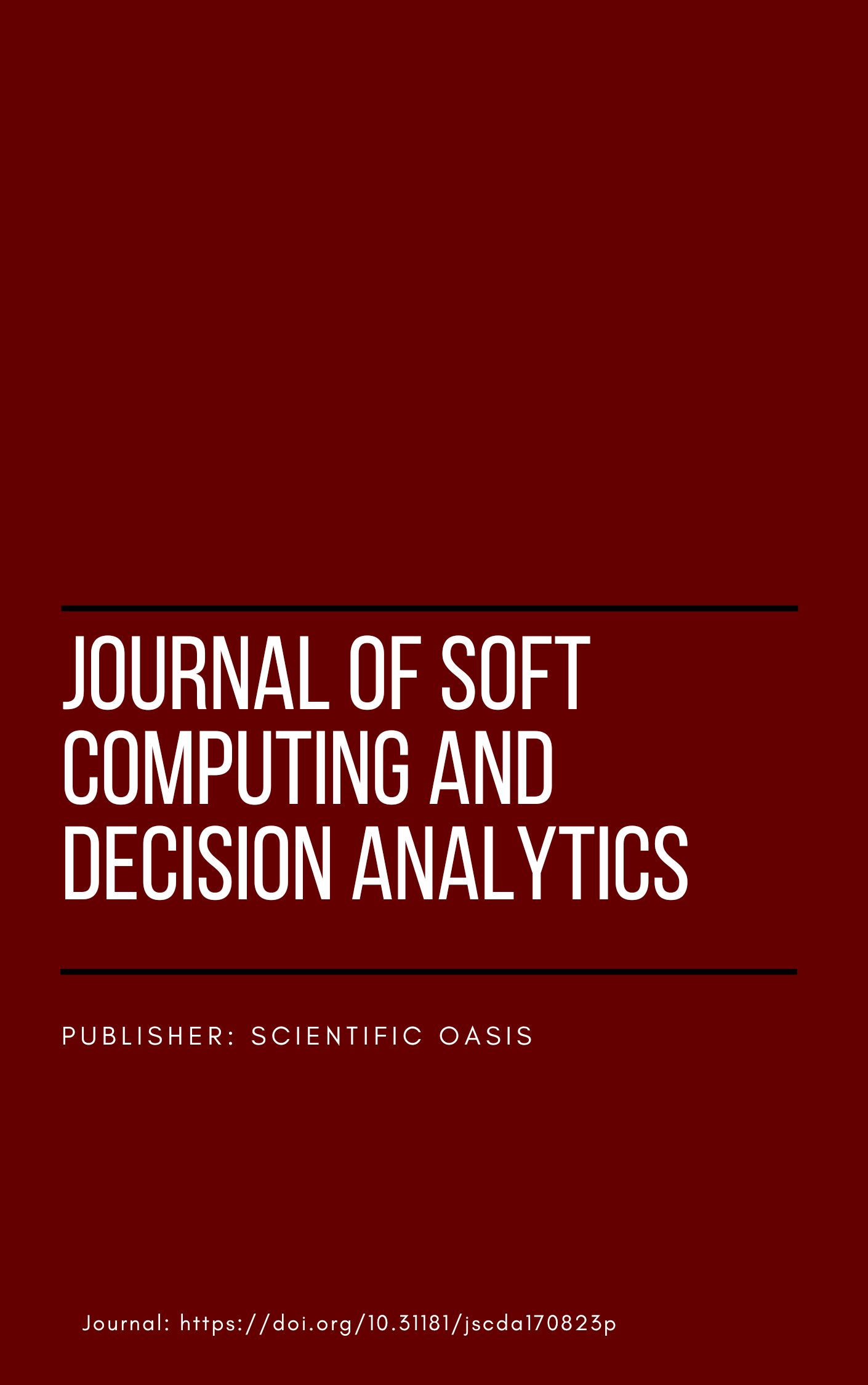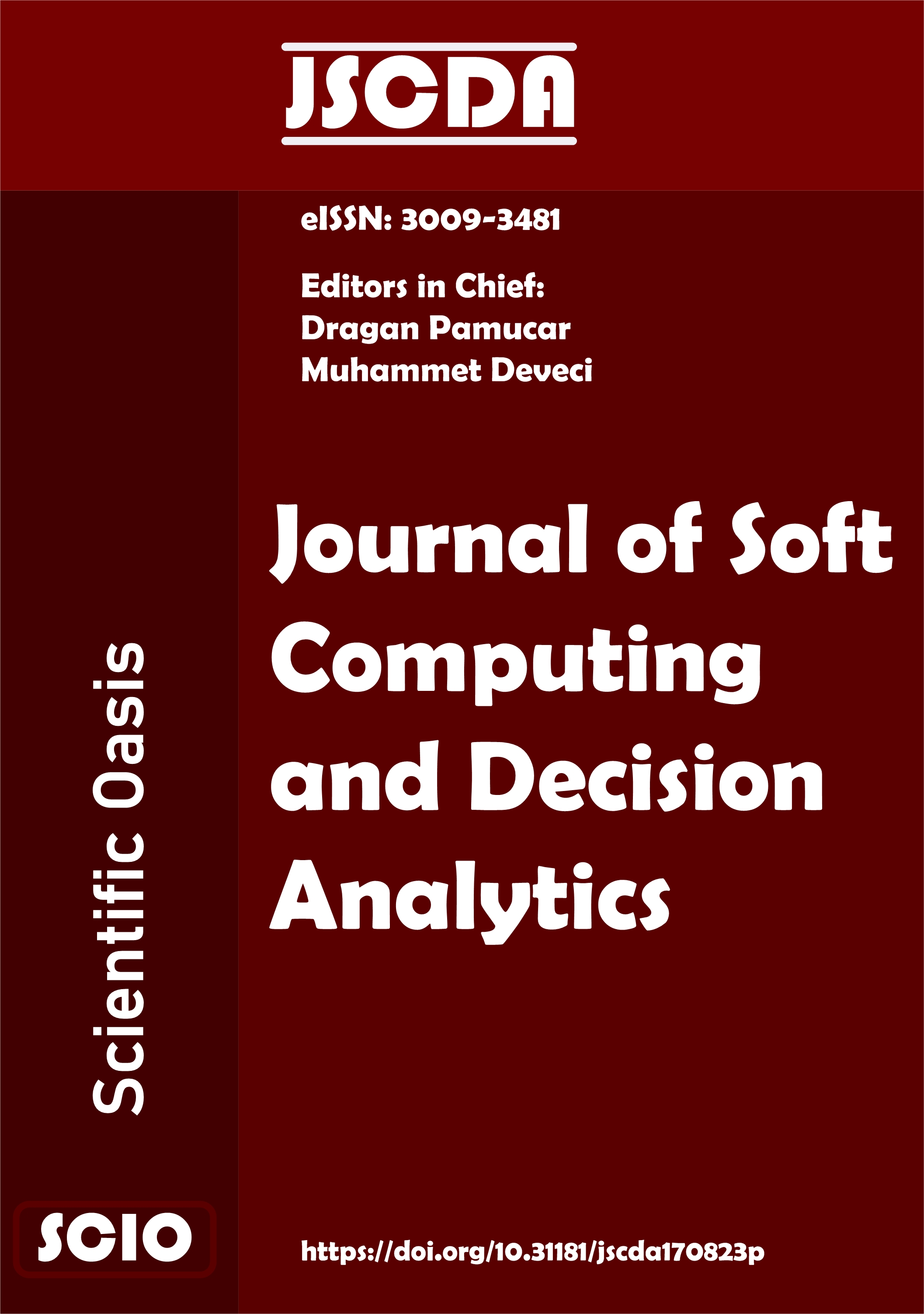Improved q-Rung Orthopair Fuzzy WASPAS Method Based on Softmax Function and Frank operations for Investment Decision of Community Group-Buying Platform
DOI:
https://doi.org/10.31181/jscda21202442Keywords:
WASPAS, Frank Operations, Softmax Function, Multi-attribute Group Decision-Making, Investment Decision, Community Group-Buying PlatformAbstract
The traditional WASPAS (Weighted Aggregated Sum Product ASsessment) method has attracted widely attention. Unfortunately, the decision-makers’ decision attitude or risk preference is ignored in the existing WASPAS methods. To overcome this shortcoming, this paper embedded expert’s decision attitude with risk preference into WASPAS method for solving multi-attribute group decision-making problems with q-rung orthopair fuzzy (q-ROF) information. We develop the q-ROF Frank softmax weighted averaging (q-ROFFSWA) and q-ROF Frank softmax weighted geometric (q-ROFFSWG) operators based on Frank operations and softmax function. The relevant properties and particular cases are explored, and the monotonicity of these operators’ score functions is analyzed. Then, the q-ROF multi-attribute group decision-making framework based on the improved WASPAS method is constructed. The weighted sum model and weighted product model in traditional WASPAS are replaced by the two proposed aggregation operators. The q-ROF distance measure is utilized to de fuzzy the performance values of alternatives. And a compromise function between optimistic and pessimistic decision attitudes with risk preferences is proposed. Lastly, the presented method is implemented in a real case of investment decision of community group-buying (CGB) platform, and sensitivity analysis and comparative study with existing methods are conducted to verify the practicality, robustness and effectiveness.
References
Xu, Z. (2009). An interactive approach to multiple attribute group decision making with multigranular uncertain linguistic information. Group Decision and Negotiation, 18, 119-145. https://doi.org/10.1007/s10726-008-9131-0
Zadeh, L. A. (1965). Fuzzy sets. Information and control, 8(3), 338-353. https://doi.org/10.4249/scholarpedia.2031
Atanassov, K. (1986). Intuitionistic fuzzy sets. Fuzzy Sets and Systems, 31, 343-349.
Yager, R. R. (2013). Pythagorean membership grades in multicriteria decision making. IEEE Transactions on fuzzy systems, 22(4), 958-965. https://doi.org/10.1109/TFUZZ.2013.2278989
Yager, R. R. (2017). Generalized orthopair fuzzy sets. IEEE Transactions on Fuzzy Systems, 25, 1222–1230. https://doi.org/10.1109/TFUZZ.2016.2604005
Zavadskas, E. K., Turskis, Z., Antucheviciene, J., & Zakarevicius, A. (2012). Optimization of weighted aggregated sum product assessment. Elektronika ir elektrotechnika, 122(6), 3-6. https://doi.org/10.5755/j01.eee.122.6.1810
Mardani, A., Nilashi, M., Zakuan, N., Loganathan, N., Soheilirad, S., Saman, M. Z. M., & Ibrahim, O. (2017). A systematic review and meta-Analysis of SWARA and WASPAS methods: Theory and applications with recent fuzzy developments. Applied soft computing, 57, 265-292. https://doi.org/10.1016/j.asoc.2017.03.045
Zavadskas, E.K., Baušys, R., & Lazauskas, M. (2015). Sustainable assessment of alternative sites for the construction of a waste incineration plant by applying WASPAS method with single-valued neutrosophic set. Sustainability, 7(12), 15923-15936. https://doi.org/10.3390/su71215792
Nie, R. X., Wang, J. Q., & Zhang, H. Y. (2017). Solving solar-wind power station location problem using an extended weighted aggregated sum product assessment (WASPAS) technique with interval neutrosophic sets. Symmetry, 9(7), 106. https://doi.org/10.3390/sym9070106
Krishankumar, R., Subrajaa, L. S., Ravichandran, K. S., Kar, S., & Saeid, A. B. (2019). A framework for multi-attribute group decision-making using double hierarchy hesitant fuzzy linguistic term set. International Journal of Fuzzy Systems, 21, 1130-1143. https://doi.org/10.1007/s40815-019-00618-w
Mishra, A. R., Rani, P., Pardasani, K. R., & Mardani, A. (2019). A novel hesitant fuzzy WASPAS method for assessment of green supplier problem based on exponential information measures. Journal of Cleaner Production, 238, 117901. https://doi.org/10.1016/j.jclepro.2019.117901
Krishankumar, R., Saranya, R., Nethra, R. P., Ravichandran, K. S., & Kar, S. (2019). A decision-making framework under probabilistic linguistic term set for multi-criteria group decision-making problem. Journal of Intelligent & Fuzzy Systems, 36(6), 5783-5795. https://doi.org/10.3233/jifs-181633
Ali, J., Bashir, Z., & Rashid, T. (2021). WASPAS-based decision making methodology with unknown weight information under uncertain evaluations. Expert Systems with Applications, 168, 114143. https://doi.org/10.1016/j.eswa.2020.114143
Sremac, S., Stević, Ž., Pamučar, D., Arsić, M., & Matić, B. (2018). Evaluation of a third-party logistics (3PL) provider using a rough SWARA–WASPAS model based on a new rough dombi aggregator. Symmetry, 10(8), 305. https://doi.org/10.3390/sym10080305
Pamucar, D., Chatterjee, K., & Zavadskas, E. K. (2019). Assessment of third-party logistics provider using multi-criteria decision-making approach based on interval rough numbers. Computers & Industrial Engineering, 127, 383-407. https://doi.org/10.1016/j.cie.2018.10.023
Aydoğdu, A., & Gül, S. (2020). A novel entropy proposition for spherical fuzzy sets and its application in multiple attribute decision‐making. International Journal of Intelligent Systems, 35(9), 1354-1374. https://doi.org/10.1002/int.22256
Ayyildiz, E., & Gumus, A.T. (2020). A novel spherical fuzzy AHP-integrated spherical WASPAS methodology for petrol station location selection problem: a real case study for Istanbul. Environmental Science and Pollution Research, 27, 36109-36120. https://doi.org/10.1007/s11356-020-09640-0
Senapati, T., & Chen, G. (2022). Picture fuzzy WASPAS technique and its application in multi-criteria decision-making. Soft Computing, 26(9), 4413-4421. https://doi.org/10.1007/s00500-022-06835-0
Ayyildiz, E., Erdogan, M., & Taskin Gumus, A. (2021). A Pythagorean fuzzy number-based integration of AHP and WASPAS methods for refugee camp location selection problem: a real case study for Istanbul, Turkey. Neural Computing and Applications, 33(22), 15751-15768. https://doi.org/10.1007/s00521-021-06195-0
Rani, P., Mishra, A.R., & Pardasani, K.R. (2020). A novel WASPAS approach for multi-criteria physician selection problem with intuitionistic fuzzy type-2 sets. Soft Computing, 24, 2355-2367. https://doi.org/10.1007/s00500-019-04065-5
Pamucar, D., Deveci, M., Canıtez, F., & Lukovac, V. (2020). Selecting an airport ground access mode using novel fuzzy LBWA-WASPAS-H decision making model. Engineering Applications of Artificial Intelligence, 93, 103703. https://doi.org/10.1016/j.engappai.2020.103703
Zhang, X., & Xu, Z. (2014). Extension of TOPSIS to multiple criteria decision making with Pythagorean fuzzy sets. International journal of intelligent systems, 29(12), 1061-1078. https://doi.org/0.1002/int.21676
Peng, X.D., & Ma, X.L. (2020). Pythagorean fuzzy multi-criteria decision making method based on CODAS with new score function. Journal of Intelligent & Fuzzy Systems, 38, 3307-3318. https://doi.org/10.3233/jifs-190043
Huang, C., Lin, M., & Xu, Z. (2020). Pythagorean fuzzy MULTIMOORA method based on distance measure and score function: its application in multicriteria decision making process. Knowledge and Information Systems, 62, 4373-4406. https://doi.org/10.1007/s10115-020-01491-y
Keshavarz Ghorabaee, M., Zavadskas, E. K., Amiri, M., & Esmaeili, A. (2016). Multi-criteria evaluation of green suppliers using an extended WASPAS method with interval type-2 fuzzy sets. Journal of Cleaner Production, 137, 213-229. https://doi.org/10.1016/j.jclepro.2016.07.031
Mishra, A. R., & Rani, P. (2018). Interval-valued intuitionistic fuzzy WASPAS method: application in reservoir flood control management policy. Group Decision and Negotiation, 27, 1047-1078. https://doi.org/10.1007/s10726-018-9593-7
Pamučar, D., Sremac, S., Stević, Ž., Ćirović, G., & Tomić, D. (2019). New multi-criteria LNN WASPAS model for evaluating the work of advisors in the transport of hazardous goods. Neural Computing and Applications, 31, 5045-5068. https://doi.org/10.1007/s00521-018-03997-7
Akbari, R., Dabbagh, R., & Ghoushchi, S. J. (2020). HSE risk prioritization of molybdenum operation process using extended FMEA approach based on Fuzzy BWM and Z-WASPAS. Journal of Intelligent & Fuzzy Systems, 38(4), 5157-5173. https://doi.org/10.1007/s00500-020-05091-4
Rani, P., & Mishra, A.R. (2020). Multi-criteria weighted aggregated sum product assessment framework for fuel technology selection using q-rung orthopair fuzzy sets. Sustainable Production and Consumption, 24, 90-104. https://doi.org/10.1016/j.spc.2020.06.015
Liu, P., Shen, M., & Geng, Y. (2023). Risk assessment based on failure mode and effects analysis (FMEA) and WASPAS methods under probabilistic double hierarchy linguistic term sets. Computers & Industrial Engineering, 186, 109758. https://doi.org/10.1016/j.cie.2023.109758
Liu, P., & Wang, P. (2019). Multiple-attribute decision-making based on Archimedean Bonferroni operators of q-rung orthopair fuzzy numbers. IEEE Transactions on Fuzzy systems, 27(5), 834-848. https://doi.org/10.1109/TFUZZ.2018.2826452
Farid, H. M. A., & Riaz, M. (2021). Some generalized q‐rung orthopair fuzzy Einstein interactive geometric aggregation operators with improved operational laws. International Journal of Intelligent Systems, 36(12), 7239-7273. https://doi.org/10.1002/int.22587
Xing, Y.P. (2021). q-Rung orthopair fuzzy Frank power point aggregation operators with new multi-parametric distance measures. Journal Of Intelligent & Fuzzy Systems, 41, 7275-7297. https://doi.org/10.3233/JIFS-211152
Darko, A. P., & Liang, D. (2020). Some q-rung orthopair fuzzy Hamacher aggregation operators and their application to multiple attribute group decision making with modified EDAS method. Engineering Applications of Artificial Intelligence, 87, 103259. https://doi.org/10.1016/j.engappai.2019.103259
Jana, C., Muhiuddin, G., & Pal, M. (2019). Some Dombi aggregation of Q‐rung orthopair fuzzy numbers in multiple‐attribute decision making. International Journal of Intelligent Systems, 34(12), 3220-3240. https://doi.org/10.1002/int.22191
Frank, M. J. (1979). On the simultaneous associativity of F (x, y) and x+ y− F (x, y). Aequationes mathematicae, 19, 194-226. https://doi.org/10.1007/bf02189866
Zhang, X., Liu, P., & Wang, Y. (2015). Multiple attribute group decision making methods based on intuitionistic fuzzy frank power aggregation operators. Journal of Intelligent & Fuzzy Systems, 29(5), 2235-2246. https://doi.org/10.3233/ifs-151699
Qin, J.D., Liu, X.W., & Pedrycz, W. (2016). Frank aggregation operators and their application to hesitant fuzzy multiple attribute decision making. Applied Soft Computing, 41, 428-452. https://doi.org/10.1016/j.asoc.2015.12.030
Zhu, D., Lu, S., Wang, M., Lin, J., & Wang, Z. (2020). Efficient precision-adjustable architecture for softmax function in deep learning. IEEE Transactions on Circuits and Systems II: Express Briefs, 67(12), 3382-3386. https://doi.org/10.1109/TCSII.2020.300256
Yu, D.J. (2016). Softmax function based intuitionistic fuzzy multi-criteria decision making and applications. Operations Research, 16, 327-348. https://doi.org/10.1007/s12351-015-0196-7
Torres, R., Salas, R., & Astudillo, H. (2014). Time‐based hesitant fuzzy information aggregation approach for decision‐making problems. International Journal of Intelligent Systems, 29(6), 579-595. https://doi.org/10.1002/int.21658
Riaz, M., Pamucar, D., Athar Farid, H. M., & Hashmi, M. R. (2020). q-Rung orthopair fuzzy prioritized aggregation operators and their application towards green supplier chain management. Symmetry, 12(6), 976. https://doi.org/10.3390/sym12060976
Aydemir, & S.B., Gündüz, S.Y. (2020). Extension of multi-Moora method with some q-rung orthopair fuzzy Dombi prioritized weighted aggregation operators for multi-attribute decision making. Soft Computing, 24, 18545-18563. https://doi.org/10.1007/s00500-020-05091-4
Liu, P., & Wang, P. (2018). Some q‐rung orthopair fuzzy aggregation operators and their application to multiple‐attribute decision making. International Journal of Intelligent Systems, 33, 259–280. https://doi.org/10.1002/int.21927
Liu, P., Chen, S. M., & Wang, P. (2018). Multiple-attribute group decision-making based on q-rung orthopair fuzzy power maclaurin symmetric mean operators. IEEE Transactions on Systems, Man, and Cybernetics: Systems, 50(10), 3741-3756. https://doi.org/10.1109/TSMC.2018.2852948
Xing, Y., Zhang, R., Wang, J., & Zhu, X. (2018). Some new Pythagorean fuzzy Choquet–Frank aggregation operators for multi‐attribute decision making. International Journal of Intelligent Systems, 33(11), 2189-2215. https://doi.org/10.1002/int.22025
Xu, Z. (2007). Intuitionistic fuzzy aggregation operators. IEEE Transactions on fuzzy systems, 15(6), 1179-1187. https://doi.org/10.1109/TFUZZ.2006.890678
Zeng, S.Z., Chen, J.P., & Li, X.S. (2016). A hybrid method for Pythagorean fuzzy multiple-criteria decision making. International Journal of Information Technology & Decision Making, 15(02), 403-422. https://doi.org/10.1142/S0219622016500012
Wang, J., Wei, G., Wei, C., & Wei, Y. (2020). MABAC method for multiple attribute group decision making under q-rung orthopair fuzzy environment. Defence Technology, 16(1), 208-216. https://doi.org/10.1016/j.dt.2019.06.019
Li, Z., Wei, G., Wang, R., Wu, J., Wei, C., & Wei, Y. (2020). EDAS method for multiple attribute group decision making under q-rung orthopair fuzzy environment. Technological and Economic Development of Economy, 26(1), 86-102. https://doi.org/10.3846/tede.2019.11333
Çakır, E., & Taş, M. A. (2023). Circular intuitionistic fuzzy decision making and its application. Expert Systems with Applications, 225, 120076. https://doi.org/10.1016/j.eswa.2023.120076
Mahmood, T., Ullah, K., Khan, Q., & Jan, N. (2019). An approach toward decision-making and medical diagnosis problems using the concept of spherical fuzzy sets. Neural Computing and Applications, 31, 7041-7053. https://doi.org/10.1007/s00521-018-3521-2
Liu, P., Mahmood, T., & Ali, Z. (2020). Complex q-rung orthopair fuzzy aggregation operators and their applications in multi-attribute group decision making. Information, 11(1), 5. https://doi.org/10.3390/info11010005
Ali, Z., Mahmood, T., & Yang, M. S. (2020). Complex T-spherical fuzzy aggregation operators with application to multi-attribute decision making. Symmetry, 12(8), 1311. https://doi.org/10.3390/sym12081311
Downloads
Published
Issue
Section
License
Copyright (c) 2024 Scientific Oasis

This work is licensed under a Creative Commons Attribution 4.0 International License.
















